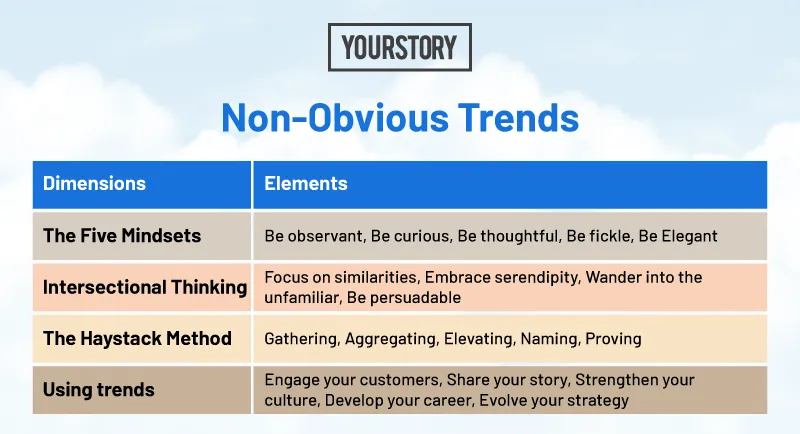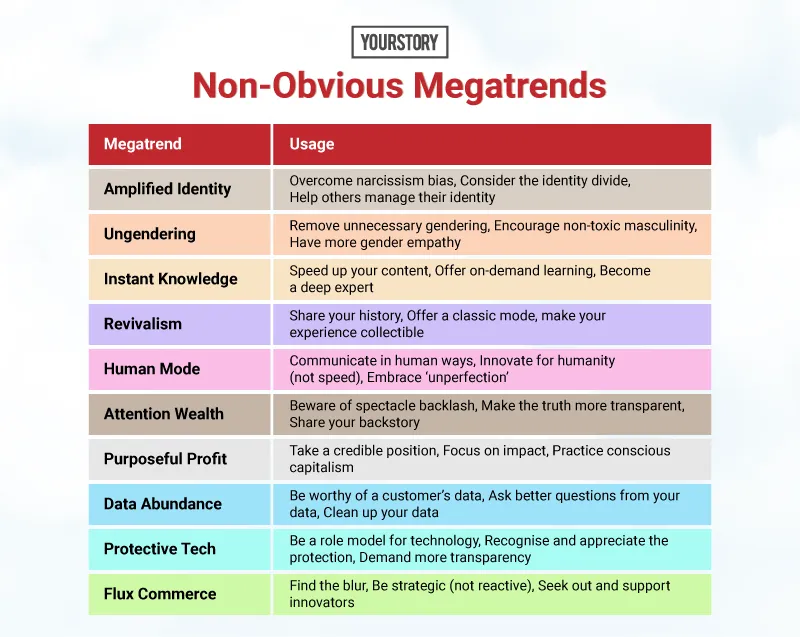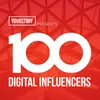Non-obvious trends and megatrends: how to become a trend curator and enhance your business
To spot and harness meaningful patterns is key for success in a fast-changing world. This best-selling author explains how to become an effective trend curator.
Launched in 2012, YourStory's Book Review section features over 285 titles on creativity, innovation, entrepreneurship, and digital transformation. See also our related columns The Turning Point, Techie Tuesdays, and Storybites.
A wealth of tips, frameworks and stories on trend spotting and curation is featured in the must-read book, Non-Obvious Megatrends: How to See What Others Miss and Predict the Future, by Rohit Bhargava.
“The future will belong to those who are uniquely able to see what others miss,” Rohit explains.
Based in Washington DC, Rohit Bhargava is Founder of the Non-Obvious Company, and author of Likeonomics, Personality not Included, and The Non-Obvious Guides. He is also an Adjunct Professor at Georgetown University. Rohit left Ogilvy after eight years to become an entrepreneur and consultant. His books and reports have been translated into 15 languages as well.
“As the world changes quickly from one day to the next, non-obvious thinking has become more urgent than ever,” the author begins. “The techniques for non-obvious thinking outlined in the book are what will really help you navigate and win the future,” he adds.
The 14 chapters are divided into three parts, and written in a manner that would appeal to a wide range of audiences, with lots of checklists, tables and examples. Readers of the book can sign up online to receive e-mail newsletters and updates. The trends described are largely focused on consumer and brand behaviour in the B2C space, but the author’s framework can be applied to other segments as well.
Here are my key takeaways from this valuable 260-page book, summarised as well in the tables below. See also my reviews of the related books Sensemaking, The Serendipity Mindset, The Creative Mindset, Cross-Industry Innovation, The Art of Noticing, and How to get to Creative Ideas.
The author also recommends a number of books for further reading, which he consulted during his work. Some of these have been reviewed by YourStory: Messy, Do Good, Life 3.0, The Inevitable, and Data Story.

Image credit: YourStory
I. Mindsets and Methods
“A trend is a curated observation of the accelerating present,” Rohit defines. “Good trends always focus on the shift in an underlying human behaviour or belief,” he adds. Trend curation goes beyond trend spotting: it adds meaning and elevates the underlying idea.
“Non-obvious thinking can help you anticipate, predict, and win the future,” Rohit emphasises. It helps to be a “speed understander” rather than a speed reader, he jokes, citing Isaac Asimov.
Rohit explains how he become an “idea curator” and even a “reluctant futurist,” starting off with his blogs on ideas and trends he spotted in articles, books and his own surroundings. In 2010, he launched his annual Non-Obvious Trend Report, which he carried on for 10 years.
These trends are different from the “lazy, uninformed, or self-serving declarations of the obvious”, and stand apart from “wishful thinking” or even “veiled pitches for products or services”, he shows.
Rohit describes the five mindsets of non-obvious thinkers. They have a growth mindset, a sense of wonder, and passion for learning. They watch processes in action, and are adept in online and offline modes. They ask questions, read outside their domains, and consider alternative viewpoints.
Non-obvious thinkers have habits like note-taking and tagging. They reflect and re-write, break things down, and keep descriptions brief. They also use poetic language like alliteration, mashups, metaphors, imagery and name twists.
These mindsets are mapped onto a curation framework that Rohit calls The Haystack Method. It has five steps: gathering, aggregating, elevating, naming, and proving.
“Gathering is the disciplined act of collecting stories and ideas while taking notes of why they are interesting,” Rohit defines.
Classifying print material into folders helps, and patterns emerge over time. Approaches based on empathy (rather than industry groups) help identify clusters. Emerging keywords can then be leveraged for creative names of trends.
“Naming is the art of describing a collection of ideas in an accessible and memorable way,” Rohit explains. The names should convey the underlying meaning in a catchy way, and can be said aloud easily. The book is packed with such examples: RetroTrust, Likeonomics, Obsessive Productivity, Virtual Empathy, and OverQuantified Life.
The final step in trend curation is validation. Elements of the idea should have already been published by authoritative sources, early adopters are already on board, and the trend is likely to continue across industries.
Rohit shows this process in action by explaining how he came up with the trend name Engineered Addiction. It was a culmination of articles about game addiction, the book Hooked, his index card Gamified Learning, a food category called Irresistible Food, and the practice of behavioural engineering.
Rohit describes examples of companies with creative products that leverage intersectional thinking and serendipitous ideas: RumChata liqueur, baby carrots, and Starbucks. For companies that want to conduct workshops on spotting trends in their own industries, he suggests facilitated brainstorming with an additive approach to idea development.

II. Megatrends and applications
The second part of the book describes 10 megatrends that are a culmination of a decade of trends. For example, Amplified Identity can be used to describe the rise of individualistic behaviours in group settings, such as selfies in social media. A selfie has been described variously as a confident self-portrait, statement of power, or ‘Everyday Stardom.’

Image credit: YourStory
Ungendering evolved from the trends Fierce Femininity and Muddled Masculinity. Instant Knowledge is a culmination of Degree-Free Learning, Distributed Expertise, and Light-Speed Learning; it is related to the rise of learning options for self-starters, and the ‘shortcut culture’.
“The Revivalism megatrend describes our widespread desire to revert to simpler times as a coping mechanism for our increasingly fast-moving world,” Rohit explains. It is manifested in a preference for print products, dumber phones, retro culture, and artisan crafts.
The Human Mode megatrend reflects desire for authentic and empathetic human experiences, even if they are less than perfect. “In a world booming with technology, there are signs that our humanity matters even more,” Rohit observes. This megatrend rides on earlier trends like Employee Heroes, Shareable Humanity, and Lovable Unperfection.
Attention Wealth is seen in the rise of social media influencers, founder/brand storytelling, sensationalism in media, and even deep fakes. Purposeful Profit is connected to Enlightened Consumption, Brand Stand, and Heroic Design.
The explosion of big data and small data will continue (Data Abundance), but the author raises concerns over quality and usability of data. Related trends are the rise of social credit and ratings that lead to profitable data – but fake social media accounts are a real worry.
Rohit describes five types of data pollution: overflow, manipulation, sabotage, contamination, and expiration.
Ubiquitous sensors can improve personal and professional life, as seen in healthcare wearables (and even ‘insideables’). However, there are also serious concerns over privacy and surveillance, which Rohit captures in the megatrend Protective Tech.
Flux Commerce is the result of continuous disruption in retail business models and channels. Lines between industries are blurring, as seen in Red Bull (media company), creative services (rise of IBM and Accenture in advertising), and the sharing economy or collaborative economy (Flexe for warehouse space, Spacious for use of restaurants as office space in off-peak hours).

III. Trends that lasted (or did not)
The last part of the book provides a superb snapshot of 10 years of Rohit’s non-obvious trends annual reports. The trends are graded from A to D, depending on how well they stood the test of time over the decade (D grade did not last more than a year). For example, the trend towards an app-only version of the web fizzled out.
Looking back at previous trends and forecasts helps understand how a society and economy evolves. “The trends can be a spark for new ideas and an instigator for innovation,” Rohit describes.
Some of the aptly-named trends over the years include Locationcasting, Social Loneliness, Co-Curation, Retail Theatre, Mefunding, Shoptimisation, Privacy Paranoia, Branded Benevolence, Glanceable Content, Experimedia, B2Beyond Marketing, Precious Print, Touchworthy, and Innovation Envy.
The road ahead
Many trends identified in the book series have actually been accelerated by the COVID-19 pandemic, Rohit observes. These include distance learning, virtual conferencing, content streaming, and the move towards universal basic income.
“The future will belong to these non-obvious thinkers who use their powers of observation to see connections between industries, ideas and behaviours and curate them into a deeper understanding of the accelerating present,” Rohit predicts.
“Preparing for the future starts with filtering out the noise and getting better at understanding the present – as it always has,” Rohit signs off.
YourStory has also published the pocketbook ‘Proverbs and Quotes for Entrepreneurs: A World of Inspiration for Startups’ as a creative and motivational guide for innovators (downloadable as apps here: Apple, Android).
Edited by Teja Lele




![[Year in Review 2020] Technology, talent, trust – 100 quotes of the year on digital transformation](https://images.yourstory.com/cs/2/28b451402d6a11e9aa979329348d4c3e/Economy3-1609336017851.jpg?fm=png&auto=format&h=100&w=100&crop=entropy&fit=crop)





